
BRUCE LEE

On 27th November 1940, the Year of the Dragon, Bruce lee was born in San Francisco. His father, Lee Hoi Chuen, was a minor star of the Cantonese Opera Company of Hong Kong, then on tour in the USA. Lee Hoi and his wife Grace named their fourth child Lee Jun Fan, which means 'Return again'. Early in 1941 the family returned to Hong Kong, but within a year, war broke out. Bruce's early years were overshadowed by the Japanese occupation. With the departure of the Japanese in 1945, the people began to reconstruct the city. Entertainment was among the first revived industries and Lee Hoi Chuen was soon back in regular acting work.
Bruce became a child movie star through his father's show business connections. By the time he was 18, he had appeared in 20 films. Bruce began learning Kung Fu in 1949. He had complained to his parents of being bullied at school and asked to be trained in the martial arts. From 1949 to 1959, Bruce attended Yip Man's kwoon (training club) to learn the secrets of Wing Chun, growing in chi (inner energy) and skill. By the time he had turned 18, he was a kung fu expert, and began to form his own ideas of style. In early 1959 Bruce was involved in a sparring encounter that turned ugly and Bruce was arrested. To secure his release it was agreed to send Bruce far away, so he returned to his birth place San Francisco.
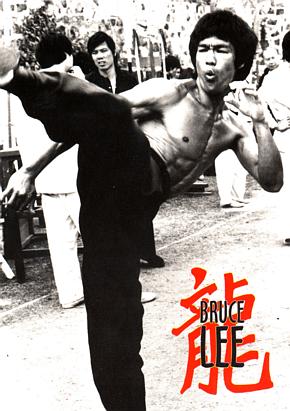
He landed in America as Bruce Lee, US Citizen. At first he lived in Chinatown, then Ruby Chow, a seattle restaurant owner offered him work. Moving to Seattle, Bruce went back to school, earned his high school diploma, and in 1962 enrolled at the University of Washington. In Seattle Bruce started teaching kung fu, to small groups of Asian martial arts fans, and later to anybody who was interested. He also constantly worked on progressing his own universal, simplified, fluid version of kung fu, which he would later term jeet kune do (the way of the Intercepting fist).
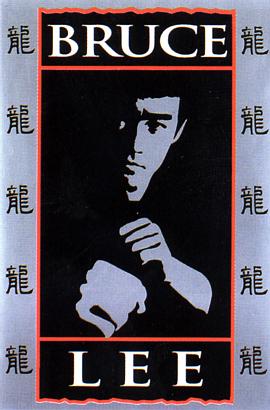
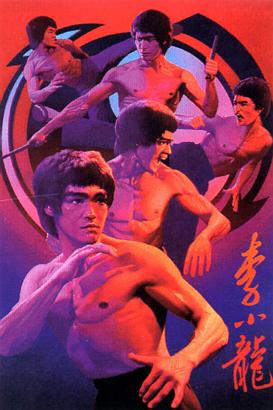
Not all of Bruce's mind was concentrated on his philosophical studies, kung fu and money. On 26th October 1963, he went on a date with Linda Emery, a fellow university student. They continued to see each other, and by 1964 had married and moved to Oakland, where Bruce had set up a second branch of his Institute. The Oakland Gung Fu Institute soon had a full roster of students, but success can attract trouble. In December 1964, the elders of San Francisco's Chinatown sent Bruce a message. They wanted him to end the lessons to non-Asians. He refused. Less than a week later Bruce was formally challenged to a fight. Losing meant closing the Institute or not teaching Caucasians. Bruce accepted immediately. One minute later the challenger had surrendered.
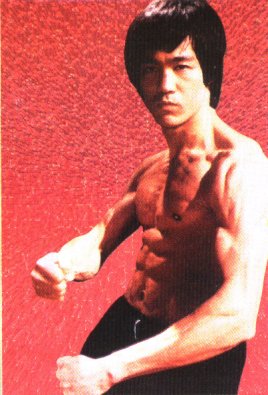
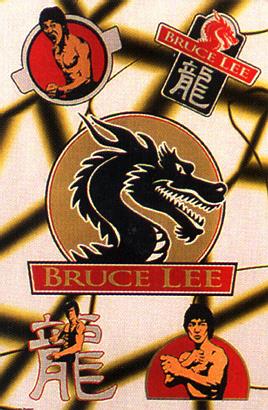
The New Year of 1965 opened with both joy and pain. A son, Brandon, was born in February. A week later, Bruce's father died. Meanwhile, the Oakland Institute was not doing so well as had been hoped. Bruce began to consider abandoning kung fu as a way of earning a living.
At the end of February, as Bruce pondered his future, he received a phone call from television producer William Dozier. He wanted Bruce for 'Number One Son' in a television version of Charlie Chan. This idea was soon scrapped in favour of a show based on the crime-fighting comic strip, 'The Green Hornet'. Bruce played Kato, chauffeur and sidekick to the hero. He was put under option for a fee of $1,800. With Hollywood beckoning, Bruce and Linda moved to Los Angeles in March 1966. The Green Hornet was short lived and before long Bruce was forced back to a dwindling income, with only occasional acting spots. On top of this during 1970 Bruce injured himself badly during a weight-lifting session.
Barely able to move, Bruce still refused to believe that he would be disabled, convinced instead that his will could triumph. After 6 months he began exercising again, and within a year seemed his old physical self. Away from the public gaze, however he would suffer chronic pain for the rest of his life. There was, though, one place in the world where Bruce could still be sure of work - Hong Kong. Raymond Chow, a Hong Kong film producer, offered him US$15,000 for two Chinese martial arts features. The money put up by Chow, plus his recent rapturous reception in Hong Kong, convinced Bruce to return to the East. In July 1971, he arrived in the remote Thai Village of Pak Chong for the shooting of the Big Boss. The premiere was set for early October in Hong Kong.
Bruce, meanwhile, was flown back to the USA by the Hollywood studio, Paramount. An episode of the crime show 'Longstreet - The way of the Intercepting Fist', guest-starring and co-written by Bruce, had just been aired to thunderous acclaim. His mind whirling with offers and counter-offers, Bruce flew to Hong Kong for the premiere of 'Thw Big Boss', accompanied by his wife Linda, Brandon and new daughter Shannon. They were met at the airport by ranks of screaming fans and frantic newsmen. The premiere of The Big Boss took place at midnight. After two hours of non-stop action, the audience went wild.
Despite seductive offers, Bruce was a man of his word and fulfilled his contract with Raymond Chow. 'Fist of Fury (Chinese Connection in the US and UK), the next film for Chow, was shot in Hong Kong. Fist of Fury smashed box-office records everywhere in South-East Asia. The critics loved Bruce's violent fighting techniques. Bruce Lee was now the hottest film property outside Hollywood.
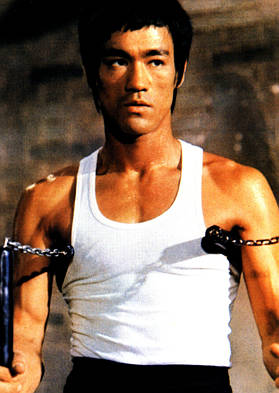
Now a free agent, Bruce decided to form a joint production company, Concord, with Raymond Chow. This put him on equal footing with Chow rather than just being the hired actor. The problem of who would direct the next Bruce Lee film was easily solved, he would do it himself. As might be expected from a directorial debut, the film had some rough edges, but audiences in Hong Kong hardly cared. 'The Way of the Dragon' grossed HK$5 million, more money than any film before it. Bruce intended it to be the first of a trilogy, but almost as soon as Way was in the can, he started work on what was to become the unfinished 'Game of Death'. But once again Hollywood beckoned, Warner Brothers made him an offer. They agreed to put up $500,000 for a martial arts movie, which would eventually reach the cinema as 'Enter the Dragon'. Meanwhile work stopped on Game of Death and footage put into storage.
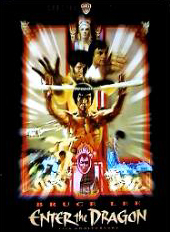
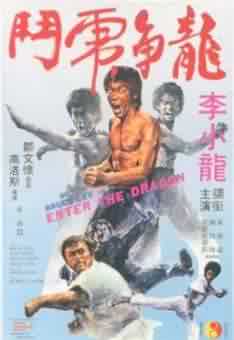
By February 1973 producer Fred Weintraub, director Robert Clouse and co-stars, John Saxon, Jim Kelly and Ahna Capri, had arrived in Hong Kong. None of the shoots on Bruce's films had been easy, and Enter the Dragon was no exception. Bruce was nervous about making his first International feature film, and delayed the start of work. His future rode on the success or failure of Enter the Dragon. He worried and worked at every aspect of it, he lost weight, and was living on vitamin pills and herbal drinks. He also became suspicious, less friendly, and a darkness settled around him. Only Linda received his complete trust.
Bruce's body finally broke down on the afternoon of 10 May 1973. He was dubbing the sound to the final print when he collapsed in a fit of vomiting and convulsions. He was rushed to hospital. Dr Peter Woo, a leading neurosurgeon, was called in. He administered the drug Manitol to reduce a swelling in Bruce's brain, and prepared for surgery if this did not work. It did.
A week later, Bruce was flown to Los Angeles for a complete examination. No abnormalities were found, and the collapse was put down to an excess fluid surrounding the brain, though its cause was not known. The collapse left Bruce shaken, but did not diminish his work rate. Bruce spent the afternoon of 20th July 1973 discussing a movie script with Chow. They then drove to the flat of Taiwanese actress Betty Ting-Pei. Soon after Chow left Bruce developed a headache. Betty gave him a painkiller. About 7-30pm Bruce lay down in a bedroom.
He was still asleep at just after 9 pm when Chow telephoned, and Betty could not wake him. Chow went to Betty's flatand called a doctor, who came immediately. At 10 o'clock an ambulance sped Bruce to the Queen Elizabeth Hospital. Doctors rushed him into an intensive care unit and tried to stimulate his heart. It was no use, Bruce Lee was already dead. He was just 32 years old.
There were two funeral ceremonies. The first was a traditional Buddhist service in Hong Kong. Outside the Kowloon Funeral parlour, a crowd of 25,000 fans wept. The second, more private, ceremony was in Seattle. Bruce was buried in the city's Lake View Cemetery, in the Chinese outfit he had worn in Enter the Dragon.
Television
Photo Page
To Brandon Lee Page
To Shannon Lee Page